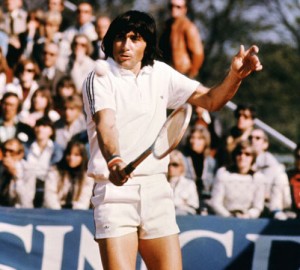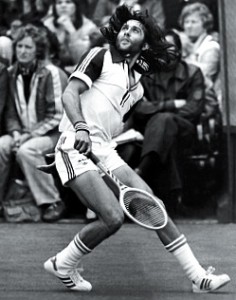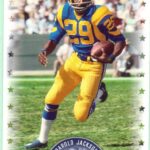Tennis Bad Boys: “Nasty” Ilie Nastase, Leader of the Pack

Ilie Nastase was the original tennis "bad boy."
Ilie Nastase permanently etched the template for tennis bad boys, setting the standard against which all are measured today. His exploits on and off the court are legendary.
The most staggering feat credited to the romantic Romanian is that he slept with over 2,500 women.
What colossal stamina! This pure speculation is based on comments from Maxim Magazine when they accorded him the sixth spot on their top ten “Living Sex Legends” list. To say Nastase was outrageous is a vast understatement.
He was born on July 19, 1946, in Bucharest, Romania.
On court, Nastase hit his stride in the ’70s. He rocketed to the top of the men’s game with a unique style and fabulous looks. In 1973, Nastase was ranked the No. 1 player in the world.
Notching the 1973 Italian and French Open championships, plus 13 other tournament wins, Nastase also took out the “Flying Dutchman” Tom Okker in the final of the season-ending Masters Tournament.
It was the final piece of an almost perfect season. With 23 tournament wins [17 singles and six doubles] Nastase set a record that he held until 1979 when John McEnroe won 27 titles in one year.

Nastase won two Grand Slam singles titles, but was also an accomplished doubles champion.
He was an enigma then and remains one to this day. His nickname in some circles was the “Bucharest Buffoon.”
Ultimately, Nastase felt compelled to entertain. He wanted to please fans sitting in the stands by making them sit up and pay attention to the action on the court.
To do that, he often mixed in unorthodox and unpredictable shots that dazzled and mystified fans and very often his opponents.
Much like today’s Frenchman, Fabrice “the Magician” Santoro, Nastase was a “sorcerer with the racket,” exhibiting panache and style.
Spontaneous and creative, he loved to cause maximum pain and difficulty for his opponent, often placing the ball just beyond his reach with the right touch and degree of spin.
He is remembered most of all, however, for his frequently bizarre and objectionable behavior on court. He could be lighthearted and joking, but was often abrasive and rude.
He would walk off the court, many times subject to fines, suspensions, and even disqualifications. At times it appeared that Nastase just did not know where to draw the line or when to quit.
At times, though, his volatile will would deteriorate and invite defeat because he lost his ability to concentrate.
In 1972 when Romania was favored to defeat the U.S. in Davis Cup on Bucharest clay, Nastase’s nerves paved the way for American Stan Smith to take the opening rubber, 11-9, 6-2, 6-3.
This loss allowed the U.S. to retain the Davis Cup and left Romania forever without that vaunted prize.
Nastase was fast at his prime,probably the fastest on tour. His exquisite skill allowed him to play serve-and-volley, but he could also execute superbly playing on the baseline.
Perhaps Nastase’s greatest accomplishments were in Davis Cup competition. Nations the size and stature of Romania almost never appeared on the world stage contesting for the Davis Cup.
Because of Nastase, Romania appeared in the esteemed finals on three occasions: in 1969, 1971 and 1972.
Unfortunately, they lost to the United States on each of these attempts. By 1985, when Nastase had been playing in the Davis Cup for 18 years, he ranked second among active players with 109 wins in 146 matches combined in singles and doubles in 52 contests (ties).

"Nasty" Nastase was one of the first players to regularly question umpires and line judges.
He also held a remarkable record in the season-closing Masters. He won the prestigious event consecutively from 1971-73 and then again in 1975. In 1974, he lost to Guillermo Vilas in five sets.
He won two grand slam championships; first, the U.S. Open in 1972 in a 5-set final against American Arthur Ashe, 3-6, 6-3, 6-7, 6-4, 6-3. This propelled him to the No. 2 world ranking.
He also won the French Open in 1973, where he defeated Nikola Pilic, 6-3, 6-3, 6-0. He won the championship without dropping a set. Later, this feat was repeated by Bjorn Borg in 1978 and ’80 and by Rafael Nadal in 2008.
Perhaps the most intriguing part of his career was his doubles play. Nastase came into the spotlight in 1966 when he teamed with his countryman Ion Tiriac and reached the finals in doubles at the French Open.
Ion Tiriac today is one of the wealthiest businessmen in Romania, and was the primary mover and shaker in creating the new Madrid Tennis Open, an event combining both the men’s and women’s tours with over $7.2 million in prize money.
Tiriac teamed with Nastase in the early days and they won the French Open Doubles championship in 1970. They also combined on several Davis Cup tie doubles with the U.S. in the early ’70s.
But Nastase also played doubles with the equally talented and often equally explosive Jimmy Connors. Together, they won the Wimbledon doubles championship in 1973, defeating John Cooper and Neale Fraser, 3-6, 6-3, 6-4, 8-9, 6-1.
He teamed with Jimmy again to win the U.S. Open doubles championship in 1975, defeating Tom Okker and Marty Riessen, 6-4, 7-6. They also teamed during the French Open in 1973 and came in second to John Newcombe and Okker.
Nastase had a long and illustrious career that spanned from amateur tours to the Open era. He remains one of five players to win more than 100 pro titles in singles and doubles. He was ranked in the top 10 every single year between 1970 and 1977.
He was inducted into the Tennis Hall of Fame in 1991. In 2005, Tennis Magazine ranked him as No. 28 on the list of the best players in the preceding 40 years.
His play has been described as gifted and mesmerizing, with delicate touch and placement the core of his game.
But his on- and off-court antics are what drew people to him and inspired players to follow in his footsteps. He remains at the pinnacle of the tennis bad boys. . .Nasty Nastase. . .
JA Allen is a regular contributor for Sports Then and Now.














